The story of “what happened” to James Leander Cathcart is remarkable enough. In 1785, when he was seventeen, the merchant ship on which he sailed was captured by Algerian corsairs, and the crew were held in captivity for eleven years before the U.S. was able to negotiate their release. During that time, Cathcart managed to work his way up to the most important, influential, and lucrative position a captive could hold, in which position he was able to assist in securing the captives’ freedom. Two years later, he returned to Barbary (as North Africa was called) as the U.S. Consul to Tripoli, thereby turning his captivity into a career.
“The Greatest Eloquence”: James Cathcart and the Power of Words in Eighteenth-Century Barbary
Cathcart’s moves through the slave hierarchy to a position of relative comfort and prosperity were accomplished partly through his ability to navigate—or manipulate—complex relationships and partly through the power of literacy.

Cathcart kept a diary during his ordeal and, many years later, adapted the diary into a narrative entitled The Captives: Eleven Years a Prisoner in Algiers. This narrative is also remarkable. In addition to relaying the details of Cathcart’s experience and his transformation from young captive to influential leader, the narrative demonstrates the power of words to change and even to create reality, not only through the story it tells but also through the public personality it forms. For the James Cathcart evoked in its pages is at odds with other historical evidence, demonstrating Cathcart’s ability with and belief in the power of words.
The Mediterranean practice of seizing ships and holding the crews for ransom or hard labor was common. In fact, the practice dated back centuries, and went in multiple directions. In the heyday of galley ships, European nations captured North Africans to work the oars; and the Catholic Church engineered an entire enterprise of “redemption” for Catholics seized by the ships of Barbary. By the late eighteenth century, European nations signed treaties with the Barbary States to protect their shipping, and these treaties were renegotiated frequently. After the American Revolution, American ships were no longer protected by British treaties, and Cathcart and his shipmates quickly learned the consequences.

The Dey (or governor) of Algiers demanded ransom for the American sailors, but the U.S. was far too poor to meet the demands, so, despite occasional attempts to free the American sailors, Cathcart, his fellow crew members, and the crews of several additional ships, were held captive until 1796. During this time, the sailors endured neglect, forced labor, abuse, and the plague. Many died.
Despite this harrowing situation, Cathcart managed to find extraordinary success. He rose from the position of a menial slave to become the “Christian clerk” of the Dey, the highest position a captive could attain, in which position he was also allowed to operate “taverns” that were apparently quite profitable. Because of his position as clerk and a remarkable facility with languages, Cathcart was instrumental in assisting the envoy from the U.S. who finally negotiated the release of the remaining captives in 1796. At that point, Cathcart himself sailed with the articles of peace back to the U.S. for ratification.
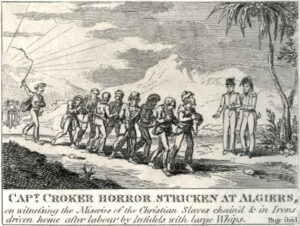
Cathcart later adapted the diary that he managed to keep during his experience in Algiers he into a narrative that his daughter subsequently saw into publication. The Captives is a complex, detailed narrative. It is part captivity narrative and part travel narrative, and also part immediate experience, shared through excerpts from his diary, and part reflective observations, filtered through the vantage points of time and later experiences in Barbary. While most Barbary captivity narratives are short and were hastily compiled when the captives returned to the U.S., Cathcart’s account is different. It was edited over several years and is longer and more well-developed than most. The text occasionally states that “Words are insufficient to describe my sensations” or that “Silence describes our feelings better than the greatest eloquence” (269), but Cathcart actually used many, many words in deliberate ways. And both the text and the events it relates demonstrate the power of words.
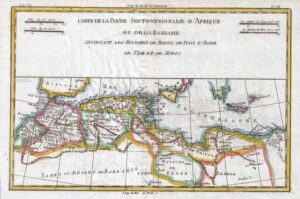
Cathcart’s moves through the slave hierarchy to a position of relative comfort and prosperity were accomplished partly through his ability to navigate—or manipulate—complex relationships and partly through the power of literacy. He mentions early on in his account that he read Spanish and French, later adding Portuguese to the list, and he acquired proficiency in Turkish. These abilities, as well as his acquaintance with the Dey’s clerk, led to his move from physical labor to working as the clerk’s assistant and later the chief clerk. His linguistic ability then positioned him to serve as interpreter when Joseph Donaldson arrived from the U.S. to settle a treaty and secure the captives’ release.

Cathcart’s depiction of the negotiations demonstrates his abilities both to translate between languages and to navigate relationships. While waiting for Donaldson to arrive, Cathcart asked the Dey for a written document to secure Donaldson’s safe passage. The Dey was reluctant to provide such a document for appearance’s sake, but Cathcart convinced him “that it need not be made out in Turkish, that [Cathcart] would write one in English which . . . [they] would keep . . . a profound secret from every person but those immediately concerned” (160-61). Cathcart found a way to ensure Donaldson’s safety while allowing the Dey to save face. During the negotiations, Cathcart’s role as interpreter gave him some power over the proceedings, and he occasionally took liberties to smooth the relationship between the two men. According to his telling of the event, the negotiations succeeded because of Cathcart’s understanding of Turkish and his understanding of the personalities involved.
In addition to his spoken words, Cathcart makes it clear that he considered his written words of concrete value to others. After depicting how he narrowly avoided being “converted” to Islam “accidentally,” Cathcart insists that his experience “ought to serve as a warning to all who read this journal and travel in those countries” (150). More immediately, Cathcart describes how he offered his “journal . . . and that part of [his] correspondence which would be useful” to Donaldson to assist him in his work (171). Cathcart, other captives, and some allies among the Europeans in Algiers told Donaldson everything that occurred in earlier attempts to free the American captives, but Cathcart insisted that his written account was necessary as well.
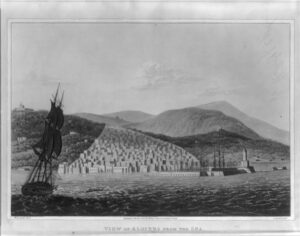
Thus, in the experiences depicted, The Captives demonstrates its author’s belief in the power of words to accomplish things. Similarly, in its construction, the narrative reveals Cathcart’s belief in the power of words to create something.
Early Americans understood and were deeply invested in the power of words. The new nation was literally created by a written document, the Declaration of Independence being a “performative utterance” that didn’t just describe a desire but established a new reality. When coining the phrase “performative utterance,” J. L. Austin indicated that this kind of speech or writing, in contrast to description, is itself an action that does something. The treaty that Cathcart translated from Turkish into English and then delivered to the U.S. government, for instance, was a “performative utterance.” By declaring “From the date of the Present Treaty there shall subsist a firm and sincere Peace and Amity between the President and Citizens of the United States of North America and Hassan Bashaw Dey of Algiers his Divan and Subjects,” this document created the “Peace and Amity” between the two nations more than it described them.
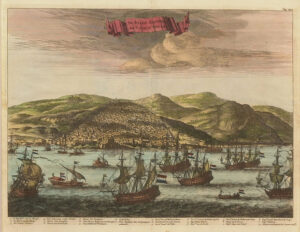
Cathcart’s narrative is, likewise, a written document that creates something: specifically, it creates a public James Leander Cathcart. As should be clear already, The Captives paints Cathcart as intelligent, even scholarly. It shows his command of many languages, shares his understanding of European-Barbary relations, and relates how he debated the tenets of Islam with a Muslim leader! Despite the title, Cathcart often comes across less as a captive and more as a world traveler, interested in learning about his unfamiliar environment and bringing his considerable knowledge to bear in making the best of unusual circumstances.
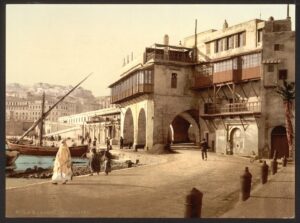
In demonstrating how he made the best of things, the narrative also relates Cathcart’s generosity. According to The Captives, he used his success to help his fellow Americans: “I believe those who survived will do me the justice to acknowledge, that they never wanted a good meal while I had it in my power to give it to them; that they were attended in the hospital when sick, and that those who died were buried in a decent coffin at my expense” (136). Looking back, the author goes so far as to “thank God that He used me a captive under a despot who many times have risked my life for the enslaved and welfare of my country” (219).
In addition to being intelligent, philosophical, and philanthropic, the Cathcart in the narrative is deeply patriotic. He recounts how he declined an offer of ransom from a British acquaintance, which would have meant freedom but would have required leaving the other Americans and living in Britain. He claims he never “once doubted the liberality of the country whose cause I voluntarily espoused when at large, but am firmly resolved to wait with fortitude becoming a Christian and an American, until my captivity expires by an honorable redemption” (153). The patriotic and long-suffering Cathcart preferred imprisonment to treason.

Finally, in this attachment to his country and the frequent comingling of the fates of the American sailors with the fate of the United States, Cathcart’s words turn his personal misfortune into a national tragedy and make Cathcart into a national hero. He refers to himself and the other captives as “the only victims of American independence” (145). While their capture did result from the new nation having no treaty with Algiers, Cathcart’s wording suggests the merchant sailors were prisoners of war, rather than victims of circumstance. In the story of leaving Algiers in 1796 to bring the articles of peace to the U.S., Cathcart claims, “From this day I date my freedom” (271), and the image of Cathcart commanding his own ship in the interests of his nation suggests he is freeing his country all over again.
All of this self-presentation in the narrative would not be especially noteworthy were it not for the different picture of Cathcart painted through other historical records; in the contrast, it becomes clear just how cleverly Cathcart crafted his image through this account. Other documents—such as letters written by or about Cathcart and descriptions of events by other witnesses—suggest Cathcart the man was argumentative, stubborn, manipulative, and pompous.
Joel Barlow, who took Donaldson’s place to implement the treaty with Algiers, wrote to the U.S. Secretary of State: “I am told that Mr. Cathcart has hopes of obtaining the consulate to this place. He has neither the talent nor the dignity of character necessary for the purpose.” It’s interesting that Barlow denounces his “talent” and “character,” while Cathcart’s narrative is at great pains to demonstrate both. Several years later, when Cathcart was again hoping to be named U.S. Consul General to Algiers, the Dey (not the same ruler for whom Cathcart worked as a captive) refused to accept his appointment, writing to President Thomas Jefferson that Cathcart’s “character does not suit us as we know wherever he has remained that he has created difficulties.”
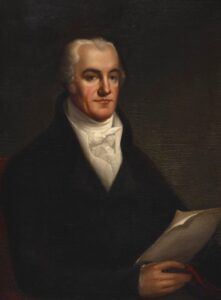
Cathcart’s claims to patriotism are also problematic. At one point, he sought freedom by writing to Member of Parliament William Wilberforce, claiming, on the basis of his Irish birth, that he wanted to return to Britain, his “long lamented Patria.” For Cathcart was born in Ireland, though he was raised in the British Colonies by an uncle. During the Revolutionary War, he served on a frigate captained by his uncle. In his narrative, Cathcart claims the frigate was seized and the sailors held on a prison ship in New York harbor, from which he and a friend escaped. This striking and adventurous story cannot be corroborated, and it’s at least equally possible that Cathcart claimed his British citizenship when he was seized and then served in the British Navy in order to escape being a prisoner of war. Naturally, neither of these events shows up in The Captives, in which any hint of split loyalty is hidden behind stirring claims to American patriotism.
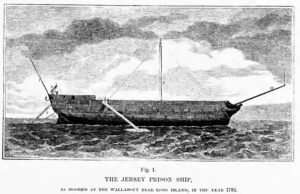
Cathcart’s abilities to understand and manipulate people, his capabilities with words, and his belief in the power of words are all clear in his experiences in Algiers in the late eighteenth century. And those same beliefs and capabilities influenced the creation of The Captives: Eleven Years a Prisoner in Algiers and of the hero at its center. Though Cathcart’s contemporaries dismissed him as, at best, a mediocre diplomat, the use of words in his personal narrative suggests a political understanding we still see today—if I write or speak something, it just might make it “real.”
Note on Sources:
Cathcart’s narrative was brought into print by his daughter, J. B. Newkirk, in 1899, and is available in online archives. It is also available through reprint services; the reprint referenced here is the unedited 2017 printing by Andesite Press. Some of Cathcart’s letters and original journal were also consulted, by way of the Proceedings of the American Antiquarian Society, vol. 64 (April-October 1954), pages 303-436, and additional letters were accessed through Naval Documents Related to the United States Wars with the Barbary Powers (1939-1944).
This essay was informed by the theoretical work related to the concept of “performative utterance” of J. L. Austin, How to Do Things With Words (Oxford: Clarendon Press, 1962); Mary Louise Pratt, Toward a Speech Act Theory (Bloomington, IN: Indiana University Press, 1977); and Jay Fliegelman, Declaring Independence: Jefferson, Natural Language, and the Culture of Performance (Stanford: Stanford University Press, 1993). It was also informed by the reading of sea narratives in Hester Blum, The View from the Masthead: Maritime Imagination and Antebellum American Sea Narratives (Chapel Hill: University of North Carolina Press, 2008). And finally this essay built upon several scholars’ treatments of the historical Cathcart: Lawrence A. Peskin, Captives and Countrymen: Barbary Slavery and the American Public, 1785-1816 (Baltimore: Johns Hopkins University Press, 2009); Robert J. Allison, The Crescent Obscured: The United States and the Muslim World, 1776-1815 (Chicago: University of Chicago Press, 1995); Richard B. Parker, Uncle Sam in Barbary: A Diplomatic History (Gainesville: University Press of Florida, 2004); and Martha Elena Rojas, “‘Insults Unpunished’: Barbary Captives, American Slaves, and the Negotiation of Liberty,” Early American Studies 1 (Fall 2003): 159-86.
This article originally appeared in August, 2022.
Julie R. Voss is Professor of English and coordinator of the English and American Studies Programs at Lenoir-Rhyne University in Hickory, North Carolina. She holds a Ph.D. in English from the University of Kentucky, where she first encountered Barbary captives while researching her dissertation on Islam in early national American texts. In addition to this topic, she writes and speaks on women writers and on pedagogy.



















